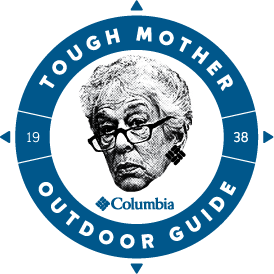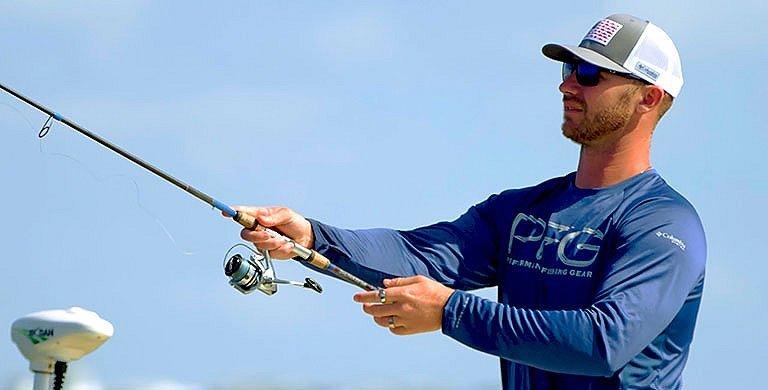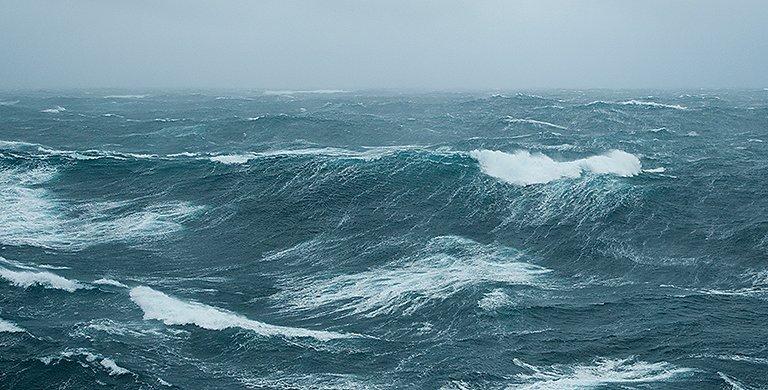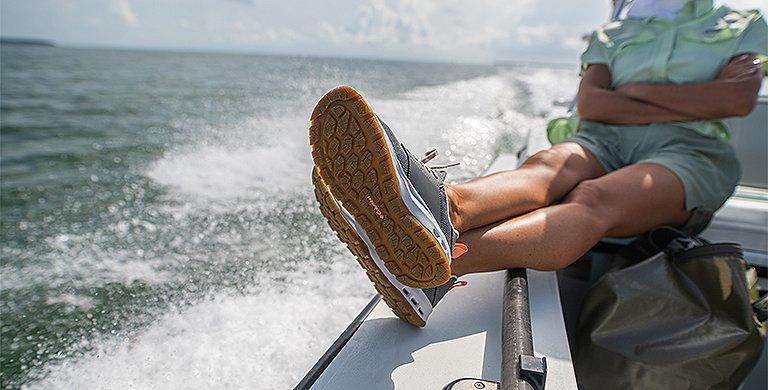FISHING
How to Start Fishing: A Beginner’s Guide
Pro angler Mark Daniels Jr. offers his best fishing tips and tricks to get started
BY DAVID YOUNG
Fishing is an incredible sport—kicking back on the side of the shore with your line in the water, enjoying all that nature has to offer. But if you've never fished before, knowing where to start can be a little overwhelming. We reached out to pro angler Mark Daniels Jr. to get his advice for the novice angler. The Alabama tournament fisherman said that fishing for him is about spending time outside.
“For me, I love just being out in nature. That's something I can count on to make me feel good every time I go out,” he said. “You’re hanging out on a shore's edge. You might have a cooler with a beverage in it, and you're really just enjoying the day. The water is splashing up against the boat or the bank. It just gives me this really primitive feeling. If you catch something, it's a bonus.”
Read on to find out more about how to get started fishing.
“For me, I love just being out in nature. That's something I can count on to make me feel good every time I go out,” he said. “You’re hanging out on a shore's edge. You might have a cooler with a beverage in it, and you're really just enjoying the day. The water is splashing up against the boat or the bank. It just gives me this really primitive feeling. If you catch something, it's a bonus.”
Read on to find out more about how to get started fishing.
Getting started fishing isn’t as complicated as you might think—you essentially just need a rod and reel setup and some bait. (Read the complete list below).
What gear does a beginner need to start fishing?
While veteran anglers may dedicate their entire garage to fishing gear, beginners don’t need much. Your fishing essentials checklist will include:
- Rod
- Reel
- Line
- Weights
- Baits or lures
- Hooks
- Tackle Box
- Measuring Tool
- Cooler (optional)
How does a beginner start fishing?
It’s not as daunting as you might think to learn how to fish. Daniels broke it down into seven easy steps:
- Step 1: Buy gear at a fishing shop
- Step 2: Get the right clothes
- Step 3: Pick a spot to fish
- Step 4: Decide what species to fish
- Step 5: Buy a fishing license
- Step 6: Practice casting and knot tying
- Step 7: Go fishing!
Step 1: Buy gear at a fishing shop
The first step in learning to fish is getting some of the basic gear and equipment needed.
“If you’ve never fished before, I think simple is best,” Daniels said. “You don't need a lot to get out there—a rod and reel, some fishing line, and a lure or two can get you out on the pond to see if it's something that you want to continue.”
Places like Cabela’s, Bass Pro Shops, Sportsman's Warehouse, DICK’S Sporting Goods, or Academy Sports + Outdoors will usually have what you need, along with any specialty fishing shop. Here are the basics:
Rod, reel, and line: These are the instruments you use to fish. The three components can be purchased separately, although when you’re first starting out you may want to opt for a combination package. According to Daniels, spinning rods and reels are the best options for beginners. “That's a type of setup that professionals use, but they're really good for the novice anglers too,” Daniels said. “They're very easy to use. They don't backlash or get tangled really easily.”
Weights: Also called “sinkers,” these gadgets help you get the bait down in the water where the fish hang out. You attach them to the line to help weigh it down. Depending on where the species you’re fishing for tends to congregate, the line will either be on the bottom of the water or somewhere in the middle.
Bait or lures: This is what attracts the fish to your line. There are two main kinds of bait: live bait and artificial bait. If you’re using live bait, look for things such as crickets, earthworms, minnows, mealworms, wax worms, or other live insects that fish will eat. If you’re using artificial bait, it will be little plastic lures that emulate the live creatures fish eat. For beginners, Daniels recommends live bait. “You don’t have to hook the fish because the swallowing mechanism causes them to hook themselves. With artificial bait, on the other hand, you have to hook them yourself at that moment they bite because they aren’t going to continue eating.”
Hooks: The bait attracts the fish, but the hook is what actually catches it. The bait or lure will go on a hook, which will hook the fish when it bites or strikes. If you’re using artificial bait, you often don’t need a separate hook because it is built into the lure.
Tackle box: The tackle box is where you store all of your accessories. The term “tackle” refers to any of the equipment you use to fish, including hooks, lures, lines, sinkers, reels, rods, and anything else.
Measuring tool: Whether it’s a ruler etched into the top of your cooler or a regular yardstick, you’ll want something to measure your fish so that you know what you can and can’t keep, according to the local regulations.
Cooler (optional): While not mandatory, it is nice to have a cooler or two on hand when you’re fishing. It doesn’t need to be fancy or fishing-specific—any basic cooler will do. Just keep in mind that if you plan on storing food or beverages in it, you may want a separate ice chest for storing any fish you catch.
“If you’ve never fished before, I think simple is best,” Daniels said. “You don't need a lot to get out there—a rod and reel, some fishing line, and a lure or two can get you out on the pond to see if it's something that you want to continue.”
Places like Cabela’s, Bass Pro Shops, Sportsman's Warehouse, DICK’S Sporting Goods, or Academy Sports + Outdoors will usually have what you need, along with any specialty fishing shop. Here are the basics:
Rod, reel, and line: These are the instruments you use to fish. The three components can be purchased separately, although when you’re first starting out you may want to opt for a combination package. According to Daniels, spinning rods and reels are the best options for beginners. “That's a type of setup that professionals use, but they're really good for the novice anglers too,” Daniels said. “They're very easy to use. They don't backlash or get tangled really easily.”
Weights: Also called “sinkers,” these gadgets help you get the bait down in the water where the fish hang out. You attach them to the line to help weigh it down. Depending on where the species you’re fishing for tends to congregate, the line will either be on the bottom of the water or somewhere in the middle.
Bait or lures: This is what attracts the fish to your line. There are two main kinds of bait: live bait and artificial bait. If you’re using live bait, look for things such as crickets, earthworms, minnows, mealworms, wax worms, or other live insects that fish will eat. If you’re using artificial bait, it will be little plastic lures that emulate the live creatures fish eat. For beginners, Daniels recommends live bait. “You don’t have to hook the fish because the swallowing mechanism causes them to hook themselves. With artificial bait, on the other hand, you have to hook them yourself at that moment they bite because they aren’t going to continue eating.”
Hooks: The bait attracts the fish, but the hook is what actually catches it. The bait or lure will go on a hook, which will hook the fish when it bites or strikes. If you’re using artificial bait, you often don’t need a separate hook because it is built into the lure.
Tackle box: The tackle box is where you store all of your accessories. The term “tackle” refers to any of the equipment you use to fish, including hooks, lures, lines, sinkers, reels, rods, and anything else.
Measuring tool: Whether it’s a ruler etched into the top of your cooler or a regular yardstick, you’ll want something to measure your fish so that you know what you can and can’t keep, according to the local regulations.
Cooler (optional): While not mandatory, it is nice to have a cooler or two on hand when you’re fishing. It doesn’t need to be fancy or fishing-specific—any basic cooler will do. Just keep in mind that if you plan on storing food or beverages in it, you may want a separate ice chest for storing any fish you catch.
Having the right clothes is important if you want to enjoy your day on the water. Opt for a fishing shirt with UPF-rated fabric and cooling technology.
Step 2: Get the right clothes
While it may be tempting to go fishing in a cotton T-shirt and jeans, having proper fishing gear will help you stay comfortable and get more enjoyment out of your time on the water. Daniels said your choice of attire will depend on the weather.
“Generally speaking, on a nice warm spring day or early summer day, I'll have on a long-sleeve PFG shirt, preferably a hooded type like the Terminal Tackle. That's my favorite shirt because it's cool and lightweight—even when it's super hot out you still feel cool in it. Yet it’s UPF-rated and protects you from the sun. Then I'll have some PFG shorts or pants and a ball cap and we're ready to roll.”
The fabrics in Performance Fishing Gear (PFG) shirts are specifically designed so you'll be able to stay cool and not overheat in warm, sunny conditions. Sun protection is important when you’re fishing, so try to find something with UPF-rated fabric, where the protection is built into the material. You’ll also want a fishing shirt with cooling technology.
“When I put on any shirt with technologies like Omni-Freeze™ ZERO or Omni-Freeze™ ZERO Ice, and that sun's beaming down when it's 80, 90, 100 degrees, I can still perform and do what I need to do, especially in tournaments. It keeps you cool when you’re fishing, which is really key,” he said.
Good footwear is important too—look for a pair of high-quality fishing shoes that allow you to maneuver safely and comfortably while maintaining your footing in wet areas.
“Generally speaking, on a nice warm spring day or early summer day, I'll have on a long-sleeve PFG shirt, preferably a hooded type like the Terminal Tackle. That's my favorite shirt because it's cool and lightweight—even when it's super hot out you still feel cool in it. Yet it’s UPF-rated and protects you from the sun. Then I'll have some PFG shorts or pants and a ball cap and we're ready to roll.”
The fabrics in Performance Fishing Gear (PFG) shirts are specifically designed so you'll be able to stay cool and not overheat in warm, sunny conditions. Sun protection is important when you’re fishing, so try to find something with UPF-rated fabric, where the protection is built into the material. You’ll also want a fishing shirt with cooling technology.
“When I put on any shirt with technologies like Omni-Freeze™ ZERO or Omni-Freeze™ ZERO Ice, and that sun's beaming down when it's 80, 90, 100 degrees, I can still perform and do what I need to do, especially in tournaments. It keeps you cool when you’re fishing, which is really key,” he said.
Good footwear is important too—look for a pair of high-quality fishing shoes that allow you to maneuver safely and comfortably while maintaining your footing in wet areas.
Step 3: Pick a spot to fish
Discovering the best fishing spots in your area is easy—it just takes a little homework. Do some research online, talk to friends who fish, or ask the people working in your local fishing shop.
Daniels explains that you usually don’t have to venture far. While rivers and lakes are great if you can get to them, there’s often plenty of great fishing in your local ponds. “It’s one of the things that almost everyone has access to, whether that's an inner-city duck pond or a spot on a rural farm a few miles down the road. Even city parks often have some form of water access.”
“People may not even know fish lived in these bodies of water or that fishing is an option there, but oftentimes it is. That's how I got started—bass fishing in an inner-city pond.”
Daniels explains that you usually don’t have to venture far. While rivers and lakes are great if you can get to them, there’s often plenty of great fishing in your local ponds. “It’s one of the things that almost everyone has access to, whether that's an inner-city duck pond or a spot on a rural farm a few miles down the road. Even city parks often have some form of water access.”
“People may not even know fish lived in these bodies of water or that fishing is an option there, but oftentimes it is. That's how I got started—bass fishing in an inner-city pond.”
Before you head out, decide what species of fish you’re hoping to catch. This will affect the type of bait you choose and what part of the water you fish in.
Step 4: Decide what species to fish
There are lots of different species of fish out there to catch. From trout to bonefish, you can talk with the person at your angling shop to help you decide and pick out the right bait for the right fish.
Daniels recommends bluegill (also referred to as “brim” or “bream”) as one great option, especially for people in the southern part of the country. They’re among the easiest fish to catch and can be found almost anywhere.
“They’re easy fish to catch because they generally roam the banks, so you don't have to cast super far out in the middle of the lake. It’s relatively easy and accessible. And they bite very simple things like earthworms, which you can dig up in your yard.”
Another good fish to start with is rainbow trout, he says, particularly for folks in the Pacific Northwest or other western parts of the country.
Species like tarpon and marlin or big sportfishing species are harder to catch and typically best for more advanced anglers.
“If somebody's never been fishing, if they catch anything, regardless of what it is, it's going to be a good experience.”
Daniels recommends bluegill (also referred to as “brim” or “bream”) as one great option, especially for people in the southern part of the country. They’re among the easiest fish to catch and can be found almost anywhere.
“They’re easy fish to catch because they generally roam the banks, so you don't have to cast super far out in the middle of the lake. It’s relatively easy and accessible. And they bite very simple things like earthworms, which you can dig up in your yard.”
Another good fish to start with is rainbow trout, he says, particularly for folks in the Pacific Northwest or other western parts of the country.
Species like tarpon and marlin or big sportfishing species are harder to catch and typically best for more advanced anglers.
“If somebody's never been fishing, if they catch anything, regardless of what it is, it's going to be a good experience.”
Step 5: Buy a fishing license
Once you’ve picked out a spot and decided what you’ll be fishing for, don’t forget to grab a fishing license.
“This is something really simple, but a lot of people make this mistake and overlook it. And that's a big ticket. You don't want that.”
You can usually get a fishing license wherever you buy your rod and reel, but if not, you can get them online from your local state agency.
Typically, a fishing license from the state will cover everything you need, but some locations might have their own too. For instance, the lake itself may require an additional stamp or tag to fish legally.
“Purchase it online, take a picture, save it to your phone, and you're good to go,” Daniels said. “You don’t even need to print it out. Just screenshot that bad boy and you're all set.”
Make sure to check how long the license is valid and renew it as needed. It is easier to get a ticket than you might think, Daniels said.
“People think, ‘Ah, it’s no big deal. No one’s around. Who cares?’ But people do care and you almost certainly will get a ticket. You’d have to encounter one of these agency officials to understand how serious they are.”
Fines vary from state to state and location to location. But generally speaking, a fishing license runs from $10 to $30 for a year, while fines for not having a license can be upwards of $300 to $700, so obtaining a license is worth the effort.
Aside from abiding by the law, it’s important to have a license for other reasons. “That money goes back into the conservation of these public bodies of water and keeping them up—stocking programs, things like that—which ensure the resources for future generations,” Daniels said.
“This is something really simple, but a lot of people make this mistake and overlook it. And that's a big ticket. You don't want that.”
You can usually get a fishing license wherever you buy your rod and reel, but if not, you can get them online from your local state agency.
Typically, a fishing license from the state will cover everything you need, but some locations might have their own too. For instance, the lake itself may require an additional stamp or tag to fish legally.
“Purchase it online, take a picture, save it to your phone, and you're good to go,” Daniels said. “You don’t even need to print it out. Just screenshot that bad boy and you're all set.”
Make sure to check how long the license is valid and renew it as needed. It is easier to get a ticket than you might think, Daniels said.
“People think, ‘Ah, it’s no big deal. No one’s around. Who cares?’ But people do care and you almost certainly will get a ticket. You’d have to encounter one of these agency officials to understand how serious they are.”
Fines vary from state to state and location to location. But generally speaking, a fishing license runs from $10 to $30 for a year, while fines for not having a license can be upwards of $300 to $700, so obtaining a license is worth the effort.
Aside from abiding by the law, it’s important to have a license for other reasons. “That money goes back into the conservation of these public bodies of water and keeping them up—stocking programs, things like that—which ensure the resources for future generations,” Daniels said.
It’s helpful to practice tying knots and casting your line at home before you’re on the water.
Step 6: Practice casting and knot tying
Before hitting the water, it can be helpful to practice some skills at home in the yard. There are tons of video tutorials and resources online that can help you practice.
“Just go into the backyard and tie a sinker on the end of the line and practice casting. Search YouTube ‘how to cast’ if you want some direction. Watch some videos and in no time, boom, you'll be a professional caster.”
Daniels explained that one common problem is tangled lines.
“You're going to get what we call backlashes or overruns. Some people simply call it a bird's nest. And that can be very frustrating. But just stay calm and relax. You’ll figure it out. That’s why practicing at home before you get to the lake helps,” he said.
It’s also helpful to practice how to tie a fishing knot so you can save time and energy on the water. Similar to casting, you can find tons of online content to assist you, or check your local fly shop for classes.
“Just go into the backyard and tie a sinker on the end of the line and practice casting. Search YouTube ‘how to cast’ if you want some direction. Watch some videos and in no time, boom, you'll be a professional caster.”
Daniels explained that one common problem is tangled lines.
“You're going to get what we call backlashes or overruns. Some people simply call it a bird's nest. And that can be very frustrating. But just stay calm and relax. You’ll figure it out. That’s why practicing at home before you get to the lake helps,” he said.
It’s also helpful to practice how to tie a fishing knot so you can save time and energy on the water. Similar to casting, you can find tons of online content to assist you, or check your local fly shop for classes.
Step 7: Go fishing!
The hard part is over. Armed with these fishing tips for beginners, all that’s left is to go out and do it.
You should also check our conversation with pro-angler Curtis Ciszek for pro tips for fly fishing.
Now it’s time to have fun and start learning to fish!
Now it’s time to have fun and start learning to fish!
Ready to go fishing? Get some UPF-rated Performance Fishing Gear.



